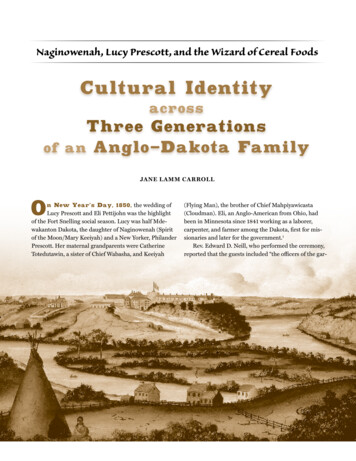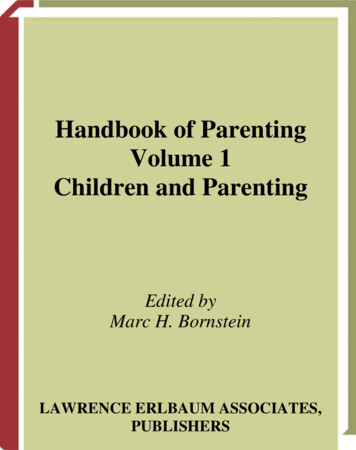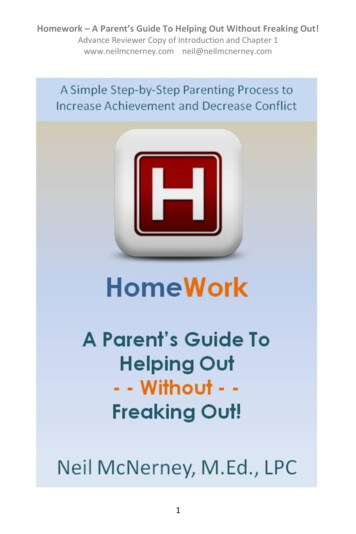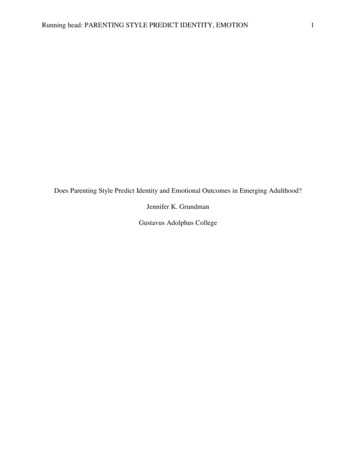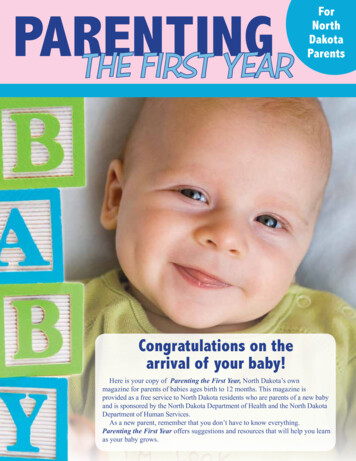
Transcription
PARENTINGTHE FIRST YEARForNorthDakotaParentsCongratulations on thearrival of your baby!Here is your copy of Parenting the First Year, North Dakota’s ownmagazine for parents of babies ages birth to 12 months. This magazine isprovided as a free service to North Dakota residents who are parents of a new babyand is sponsored by the North Dakota Department of Health and the North DakotaDepartment of Human Services.As a new parent, remember that you don’t have to know everything.Parenting the First Year offers suggestions and resources that will help you learnas your baby grows.
Be Patient With YourselfBecoming a parent is an excitingchange in your life. However, it willtake time to feel comfortable in yourimportant new role. Parents and babieslearn together. Don’t expect to knowhow to handle everything overnight.Mothers, during the first few weeksafter your baby is born, you may besurprised by your strong feelings. Youmay feel thrilled, proud or on top ofthe world. Sometimes, you may feeldown or on the verge of tears forapparently no reason. Some call thisthe “baby blues.” If the “baby blues”lasts longer than two to three weeks, orif these feelings keep you from caringfor yourself or your baby, talk to yourhealth care provider.Of course, fathers and mothers mayfeel worn out and tired. Most parentshave these feelings. Try to keep yourdays as simple as possible. Ask nothingof yourself but the basics. If possible,plan to nap or at least rest when yourbaby does. Be flexible.When you’re having a rough time,talk to your partner, a family memberor a good friend about your feelings.It helps to talk with someone who hasbeen through the same experience.There may be new parent groupsin your area. If your feelings seemextreme or last for longer than twoto three weeks, call your health careprovider.He or She, Him or HerThese newsletters give equaltime to both sexes. That’s whywe take turns referring toyour baby as “he” or “she.”Keep in mind that we aretalking about all babies whenwe use “he” or “she.”2Your Newborn Wants You To Know I like to look at your face, contrasting colors, mirrors and patterns.I feel comforted when you hold me and talk to me.I recognize my mom’s and dad’s voices right away.I stare at things, but I don’t grab for them yet.I get scared by loud noises, bright lights and rough handling.I notice things around me when you change my position.I can see things best when they are about eight to 12 inches away.I like to be cuddled and talked to while I eat.Your 3-Month-Old Wants You To KnowHow I Grow I can hold my head up for a few minutes when I’m on my tummy, but it stillwobbles a little. I wave my arms and “bicycle” with my legs when I am excited. I can hold onto things you give me for a little while. I’m more interested in things. I like to look around and to listen. I might stay awake as long as 10 hours a day and sleep as long as seven hours anight – but don’t count on it! Be patient with me when I wake up at night.How I Talk I gurgle and smile when I’m happy. I try cooing sounds. Say them back to me! I cry to let you know when I need something.How I Respond I’m fascinated by my hands.I like to follow you with my eyes when you move around. I watch objects, too.I smile at people.Sucking on my hand or a pacifier helps me calm down.I perform to get attention. I love it when you get excited about what I can do.How I Feel I need lots of cuddling and holding.How I Understand I recognize some people by their voices. I recognize a few things, like my favorite rattle or a bottle.How You Can Help Me Learn Put me on my tummy when I’m awake and someone is watching me.Change my position often so I can see different things.Take me for a walk or out to the store. I like to see and hear what’s happening.I like the feel of soft fabric and different textures.Babies are very different from each other. Don’t worryif your child manages some skills earlier or later than otherchildren. Get to know your unique baby and celebrate eachnew skill with him! If you have questions about your baby’sdevelopment, contact your health care provider and/ordevelopmental specialist. See page 23 for help finding adevelopmental specialist.Parenting the First Year
Check Your Crib for SafetyMore infants die every year in incidents involving cribs than any other nursery product. Use a crib that meets federal safetystandards set by the U.S. Consumer Product Safety Commission (CPSC). All cribs sold in the U.S. after June 28, 2011, mustmeet new federal safety standards for overall crib safety.Check your crib for safety: Cribs that are assembled wrong, have missing, loose or broken hardware or broken slats can result in entrapment orsuffocation deaths. Infants can strangle when their bodies slip through unsafe openings and their head and neck becomeentrapped in gaps created by missing, loose or broken hardware or broken slats. Crib slats should be no more than 2 3/8 inches apart (the width of a soda can), so baby’s body cannot fit through the slats. Crib mattress should be firm and fit tightly against all four sides of the crib. If you can fit two or more fingers betweenthe mattress and the sides, get a better fitting mattress. Make sure corner posts of the crib are not greater than 1/16-inch high so baby’s clothing cannot catch. Crib headboards or footboards should not have cutouts. Cutout areas on panels can trap an infant’s head. Do not use cribs with traditional drop-side panels. These cribs do not meetthe new crib safety standards. Check the crib frequently to make sure all hardware is secured tightlyand there are no loose, missing or broken parts. Do not use pillows, quilts, comforters, sheepskins, stuffed toys, bumper pads and other soft products in the crib that may suffocate baby. Do not use a crib with plastic latches holding up the mattress. If theplastic breaks, one corner of the mattress can slip down and theCribs for Kids is a safe-sleepbaby’s head could get caught under the side.education and distribution program for Keep baby’s crib away from windows so he can’t reach and becomelow-income families to help reduce thetangled in the blinds or curtain cords. Use cordless window coveringsrisk of injury and death of infants duein homes with young children. If you cannot afford new cordlessto unsafe sleep environments. Thewindow coverings, contact the Window Coverings Safety Councilprogram addresses specific situationsat 800.506.4636 or www.windowcoverings.org to order free kitsdealing with socioeconomic issuesto make window coverings safer.such as crib affordability and cultural Make sure your baby’s child-care provider is using a safe crib.practices such as bed sharing andAfter December 28, 2012, child-care providers must onlysecondhand smoke.use cribs that meet the crib safety standards that were madeCribs for Kids was developed ineffective June 28, 2011.Pittsburgh, Penn., to address the issue Never leave an infant on an adult or youth sized bed, waterbed,of babies dying when placed in unsafebean bag, couch or other soft surface. An infant can get trappedsleeping environments. The Northand suffocate between the mattress and the wall or bed frame.Dakota Department of Health becamea Cribs for Kids partner in late 2009.For mesh-sided cribs or playpens, make sure they have:Screening is completed by local Mesh less than 1/4-inch in size; smaller than the tiny buttons on a baby’spartners and eligibility varies by siteclothing.and is based on availability. Crib Kits Mesh with no tears, holes or loose threads that could entangle a baby.for eligible pregnant and newly Mesh securely attached to top rail and floor plate.delivered mothers feature a Graco A top rail cover with no tears or holes.Pack n’ Play, No staples missing, loose or exposed.crib sheet, All sides locked in the up position before placing baby inside.pacifier anda swaddleFor more information about crib safety and safety standards,sack.or to check your crib for recall, visit the CPSC atTo find out more about the cation-Centers/cribs,and for a list of local partners, visitor call 800.638.2772.www.ndhealth.gov/cribsforkids orcall 800.472.2286 (press 1).Help Available fromNorth Dakota’s CribsFor Kids ProgramBirth to 12 Months3
Your Baby’s SensesYour New BabyYour baby has all the same senses you do. Even at birth, babies can see, hear,smell, touch and taste.Very few babies enter the worldlooking as they do in magazines andTV ads. Pointy heads, blotchy skin andpuffy eyes are much more common.It’s a little bit scary at first to carefor a tiny infant, but you’ll gainconfidence with time.Vision Babies prefer to look at faces. For the first few weeks of life, they see best at adistance of eight to 12 inches. Bright colors, high-contrast patterns and shiny things are more interesting tobabies than pale colors. Babies may follow moving objects with their eyes for a few seconds. Duringthe first weeks, their heads turn to the side when they lie down. As babies reacha couple months of age, they often show pleasure with parents and smile backwhen you smile.Hearing Babies may turn their heads toward the source of an interesting noise. They prefer high-pitched, gentle voices. When your baby is upset, soft musicmay help calm her. Infants recognize their mom’s and dad’s voices within days or weeks after birth. Parents can help by following up on any abnormal hearing screening.Smell Even young babies react to smells. Strong, harsh smells will make a baby turnher head away and cry. By one week of age, babies know the smell of their own nursing mothers.Touch Touching is very important to babies. Being held close and cuddled helpsbabies know their world is a friendly place. Hold your baby, or “wear your baby” by using an approved baby sling orcarrier. Being inyour arms andhearing yourheart beat makesyour baby feelsafe and secure. Cuddle and holdyour baby whenever you want to.Don’t worry aboutspoiling her.Babies are supposedto be babied. Babies can sensemovement fromvery early on.Motion, like rockingand walking, helpscalm a crying baby. Remember, she spent nine months floating inside theuterus, so she is used to rocking and moving around.Taste Babies can taste the difference between sweet and sour just like you can.However, babies should taste only breast milk or formula at this age.4Jaundice and YourNewbornJaundice is the yellow color seenin the skin of many newborns when abrownish-yellowish substance calledbillirubin builds up in the baby’sblood. Mild jaundice is harmless, butvery high levels that are not medicallytreated can cause brain damage.Newborns are checked forjaundice before leaving the hospital.Once home, call your doctor if yourbaby’s skin turns more yellow, thewhites of his eyes turn yellow, or heis hard to wake, is fussy or is notfeeding well.Parenting the First Year
Crying ., Crying .and More CryingSometimes, it may seem like yourbaby never stops crying. This can bevery stressful and hard to listen to, butdon’t take your angry feelings out onhim – he can’t help it.Never shake a baby! Shaking ababy can result in shaken babysyndrome, a serious type of headinjury that causes brain damage oreven death.If you feel like you’ve had enoughand your patience is wearing thin, trythese tips: Put the baby in his crib andshut the door. Take a shower or vacuum. Youwon’t hear him, and the noisemight calm your baby. Look inon him every 15 minutes untilbaby settles down or until youfeel calm enough to deal withyour crying baby. Ask a friend or relative towatch your baby. Everyoneneeds a break like this at times.If you think your baby is ill, callyour health care provider. If you needto talk to someone, you can call FirstLink at 2-1-1, 701.235.7335, or 888223.6462 24 hours a day. Visit www.preventchildabuse.org for additionalresources.Birth to 12 MonthsWhy Do Babies Cry?I’m hungry – Most newborns eat every few hours around the clock. Some babiesbecome frantic when hunger strikes. This cry often has a very rhythmic quality.I’m lonely – If your baby calms and stays calm as soon as you pick him up, hemissed you!I’m too hot or cold – Feel your baby’s back or tummy to see if he is too cool ortoo hot. Adjust clothing to make him comfortable. Dress him as you dressyourself. Newborns may want to be wrapped in a blanket to feel secure.I’m tired – Tired babies are often fussy. Newborns often sleep 16 hours or moreevery day.I’m overstimulated – Lots of people holding or talking to the baby at once mayoverdo it. Rocking him in a dimly lit room may help. White noise such as arecording of ocean waves or the monotonous sound of an electric fan or vacuumcleaner may help your crying baby relax.I’m startled – Your baby may move suddenly, startle and cry. Wrapping a blanketsecurely around him and holding him firmly may calm him.I’m wet – Some babies don’t mind; others do.I want to suck on something – Sucking is a natural reflex. For many babies, it’s acomforting, soothing activity. If your baby isn’t hungry, give him a pacifier.I’m hurting – Your baby may be uncomfortable because his clothes have sharptags or zippers. Your baby may have a stomach ache. If you’re breastfeedingyour baby, the flavor of the milk may change in response to a certain food ordrink. These cries tend to be louder and higher pitched.It’s just that time of day – Many babies have predictable periods of fussiness,often in the late afternoon and early evening. There may be little you can do butcomfort your baby as the crying runs its course.Comforting Crying BabiesThe second month of life tends to be the peak for crying. After this month, yourbaby may not cry as often. Here are some suggestions to help calm your crying baby: Provide steady, continuous sounds. The sound of a running vacuum cleaner,washer or dryer may be soothing. Try singing quietly to the baby. Sometimes arecording of a human heartbeat or white noise such as the sound of the oceancan be comforting. Cuddle your baby. Babies need lots of holding and touching. Nurse or feed your baby. Leave a soft light on in your baby’s room and turn on a fan. If she has diaper rash, wash her bottom with mild soap and water and leave thediaper off for a while to let her skin dry. Apply ointment to soothe and protectthe skin. Take your baby for a walk. Use a safety-approved baby carrier, or strap yourbaby safely in a stroller. Take your baby for a car ride. Remember to strap your baby safely in a carseat every time. Sing to your baby.If you have questions about your child’s health-care needs, call the NorthDakota Department of Health at 800.472.2286 (press 1) for information andresources.5
Which Car Seat ToUse for BabyChildren (all infants andtoddlers) should ride rear-facing inan infant seat or convertible seatuntil they are 2 years of age.Maximum weight limits forinfant seats are generally 22 to 35pounds. Babies who outgrow theirinfant seat should be moved to arear-facing convertible seat, whichgenerally can be installed rearfacing and used for up to 30 to 40pounds.When rear-facing, the child’shead should never be closer thanone inch from the top of the carseat.Use Your Rear-Facing Car Seat CorrectlyProtect your baby every time you travel. Vehicle crashes are a leading cause ofinjury and death to babies and toddlers. Using a car seat is the best way toprotect your baby in a moving vehicle, but the seat must be used correctly. InNorth Dakota, five out of six car seats are used incorrectly. Don’t wait until youhave a crash to find out that the car seat was being used incorrectly. For help inusing your car seat, always read and follow the car seat instructions for your carseat AND the owner’s manual for your vehicle. If you have questions about how tocorrectly use your car seat, get help from a child passenger safety technician. Callthe North Dakota Department of Health at 800.472.4486 (press 1) for a list of carseat checkup technicians in your area. Follow these basic rules to help keep yourbaby safe in the vehicle: Never place a rear-facing car seat in front of an air bag. Air bags explode atspeeds of 100 to 200 miles per hour. Register your car seat with the manufacturer so you can be notified if your carseat is recalled. You can do this by sending in the registration card, calling themanufacturer or entering it online. Adjust the harness straps to the slots at or below your baby’s shoulders forrear-facing. The harness straps should be snug on your baby so that you can’t pinch anyslack in the webbing. If using blankets, strap baby in first, then place blanketover straps on baby. The harness chest clip should be placed on the chest between baby’s armpits. Rear-facing seats need to be reclined when installed in the vehicle. Followinstructions on how to recline the seat to ensure baby’s head is not fallingforward (cutting off airway). Install the car seat using either the seat belt OR the lower anchors located in thevehicle, not both. Read your vehicle owner’s manual. Install the car seat tight enough so it doesn’t move more than one inch. Pullforward and side to side to check for a tight install.For more information about child passenger safety, contact the North DakotaDepartment of Health, Child Passenger Safety Program, at 800.472.2286 (press 1).Need a Car Seat?Contact the local publichealth unit in yourcounty or theNorth DakotaDepartment of Healthat 800.472.2286(press 1) for moreinformation aboutcar safety seatprograms inyour area.6Parenting the First Year
Feeding Your BabyFeeding is an important learning time for a new baby. The American Academy of Pediatrics recommends that infants beexclusively breastfed for the first six months of life. After introducing solid foods, babies should continue to breastfeed for ayear, or as long as is mutually desirable by the mother and baby. For infants that are not breastfed, iron-fortified formula is to beused until the infant turns 1 year of age. Some babies may need special formula as recommended by their health care provider.Babies usually give cues when they are hungry. Watch your baby, not the clock, to figure out when to feed her. Your baby ishungry when she starts moving around, smacking her lips or sucking her hands. Try to feed her before she cries, as cryingbabies can be hard to feed. When she is full, she will fall asleep, relax her arms and hands and stop sucking, or drop off the nipple.Be flexible. Many babies, if fed when they’re hungry, will start to get on a regular schedule by themselves in about a month.Breastfeeding TipsAll babies are different. One baby may nurse 10 to 30 minutes at both breasts, while another may nurse 10 to 30 minutes atjust one breast. Although on different schedules, both babies get enough. You will know your baby is getting enough to eat when: By the end of the first week, she has six or more wet diapers and four or more soiled diapers a day. She seems satisfied and relaxed after nursing. You can hear or see her swallow when she nurses. She wants to nurse 10 to 12 times per day, usually every 1½ to 3hours. She gains weight. Your baby may lose some weight after birth, butshe should be back to her birth weight by 2 weeks of age. Aftergetting back to his or her birth weight, babies usually gain four toeight ounces per week for the first few months of life. Your breasts feel less full after a feeding.Babies have growth spurts during which they want to nurse moreoften – possibly every hour. Because you are nursing all the time it mayseem like you don’t have enough milk, but that’s not true. By nursingmore often, you are letting your body know it needs to make more milk.Pacifier use should be avoided for the first four weeks in order toestablish a good milk supply. Offer the breast to comfort your newborninstead of a pacifier.If you have questions or concerns about breastfeeding, contact yourhealth care provider or a nutritionist from your Local Public Health orWIC office, or visit www.ndhealth.gov/breastfeeding.Formula Feeding Tips Find a comfortable place for feeding.Hold your baby in your arms or lap during the feeding. Do not use a pillow oranother object to support the bottle while she eats. This practice of proppingthe bottle can cause your baby to choke or overeat and can increase her risk ofear infections.Show your baby lots of love, attention and cuddling while feeding.Be sure to follow the manufacturer’s instructions on the label so that theformula is mixed properly.Feed your baby about every two to three hours. Watch for feeding cues toknow when your baby is ready to eat and when she is finished eating. Yourbaby is the best judge of how much she needs to eat, so don’t force her tofinish the entire bottle.Baby Bottle Tooth DecayIf your baby has a bottle in her mouth all night, the juice and/or milk sugars maycause cavities on her teeth. Children generally don’t start losing baby teeth untilabout age 6 or 7. The whole tooth shedding process can last until age 13. Baby teethare important for multiple reasons, including maintaining space and guiding theadult/permanent teeth into position.For more information about oral health care, call the North Dakota Departmentof Health’s Oral Health Program at 800.472.2286 (press 1) or visitwww.ndhealth.gov/oralhealth/.Birth to 12 Months7
Babies Sleep Safest on Their BacksWhat is a Birth Defect?The American Academy of Pediatrics recommends infants (birth to 12 months)sleep on their backs. Back sleeping provides the best protection against suddeninfant death syndrome (SIDS), which is the sudden and unexplained death of ababy younger than 1 year of age. To reduce the risk of SIDS, follow these steps:A birth defect is something thathappens while the baby is developingin the mother’s body. Birth defectscan vary from mild to severe and mayaffect how the body looks, functions,or both. Some birth defects (such ascleft lip or clubfoot) are easy to see,but others (such as heart defects) arefound using special tests such as x-raysor ultrasounds.Most birth defects happen during thefirst three months of pregnancy whenthe organs of the baby are forming.In the United States, about 3 percent ofbabies are born with birth defects (oneof every 33 babies). Most birth defectsare thought to be caused by a complexmix of factors such as our genes,our behaviors and things in theenvironment. The causes for about 70percent of birth defects are unknown.If your baby was born with a birthdefect and you need more information,call Children’s Special Health Servicesat 800.755.2714 or 701.328.2436.You can also send an e-mail todohcshsadm@nd.gov or go towww.ndhealth.gov/cshs.Safe Sleep Top 101. To reduce the risk of SIDS, women should get regular health care duringpregnancy, and not smoke, drink alcohol or use illegal drugs during pregnancy,or after the baby is born. Do not allow smoking around your baby.2. Always place your baby on his back to sleep. Every sleep time counts, evennaps. Discuss safe sleep with everyone who cares for your baby.3. Place your baby on a firm sleep surface such as a safety-approved cribmattress, covered by a fitted sheet. Never place your baby to sleep on pillows,quilts, sheepskins or other soft surfaces. Keep soft objects, toys, loose beddingsuch as blankets and sheets, crib bumpers and any extra objects out of yourbaby’s sleep area. Consider using a sleep sack instead of a blanket.4. Keep your baby’s sleep area close to, but separate from where you and otherssleep. Your baby should not sleep on a bed, couch or armchair with adults orother children, but he can sleep in the same room as you. If you bring yourbaby into bed with you to breastfeed, put him back in his own crib for sleep.If your baby falls asleep in a car seat or swing, move him to a safe sleepingarea to continue sleeping.5. Breastfeeding your baby is recommended.6. Consider offering a pacifier when placing your infant down to sleep. Wait untilbreastfeeding is well established before offering a pacifier, usually at about3 to 4 weeks.7. Do not let your baby overheat. Dress your baby in light sleep clothing andkeep the room at a temperature comfortable for an adult.8. Avoid products that claim to reduce the risk of SIDS, including homemonitors and positioners. Most have not been tested for effectiveness or safety.9. Reduce the chance of flat spots developing on your baby’s head by providing“tummy time” when your baby is awake and someone is watching him closely.You can also change the direction that he lies in the crib from week to week.Sitting devices such as car seats, infant swings and bouncy chairs are notrecommended for routine sleep.10. Follow health-care provider guidance about your baby’s vaccines and regularhealth checkups.For more information, visit www.ndhealth.gov/sids, www.nichd.nih.gov/sts/Pages/default.aspx, www.cjsids.org or call 800.472.2286 (press 1).8How do I take care ofmy child’s teeth?Parents should start cleaningtheir baby’s mouth soon afterbirth. After each feeding, wipe thebaby’s gums with a clean, dampwashcloth or gauze pad. Switchto a small infant-size soft-bristledtoothbrush as soon as the first teethappear. A small horizontal swipeof toothpaste should be used whenteeth are present. The AmericanDental Association recommendsthat babies be seen by a dentistwhen the first tooth comes in.Contact your current or futuredentist for further informationregarding his/her preferences.Parenting the First Year
Q &AWhat type of watershould I use for mybaby’s formula?Water used to make formulamay come from city water (treatedby a treatment plant), private (well)water or bottled water. City drinking water supplies are regulatedby the Environmental Protection Agency (EPA) and tested tomaintain optimal fluoride content.Bottled water is regulated by theU.S. Food and Drug Administration(FDA) and may not containfluoride, unless the fluoride hasbeen added during the packingprocess and is noted on the label.Well water may contain somefluoride, but also may containcontaminates like bacteria andnitrates that may be harmful forbabies, children and pregnantwomen. Private wells should betested periodically to make sure thewater is safe for human consumption. For information about havingyour well tested, contact the NorthDakota Drinking Water Program at701.328.5258.Fluoride combines with toothenamel in two ways: (1) throughingestion of water and food, and(2) through the use of toothpaste tostrengthen and protect teeth againstcavities. For babies, the mosteffective way to receive fluorideprotection is by drinking formulamade with water containing theoptimal amount of fluoride.Discuss any fluoride concernsor questions with your dentist and/or health care provider. To viewfluoride content in your area, visitapps.nccd.cdc.gov/MWF/Index.asp.For more information, contactyour local public health unit, visitwww.ndhealth.gov/localhd/, visitwww.ndhealth.gov/mf/, or call theNorth Dakota Department of Healthat 701.328.5211.Birth to 12 MonthsPostpartum Depression Babies Sunburn EasierFactsThan AdultsPostpartum depression is a type ofdepression that affects one in 10 newmothers. It usually occurs during thefirst two to four weeks after delivery.Common signs include cryingfrequently, sleeping too much or toolittle, feeling hopeless, experiencingsevere mood swings, having troublemaking decisions, and expressingexcess concern or lack of concern foryour baby.If you feel you may be sufferingfrom postpartum depression, contactyour health-care provider immediately.Postpartum depression can be treatedsuccessfully by a medical professional.For more information, visitwww.ndhealth.gov/familyhealth/(click on Infant Care and Info forMothers, Fathers and Caregivers),or call the North Dakota HELP-LINEat 2-1-1.Sunburn can have seriousconsequences for babies. Your infantcannot cover himself or move out ofthe sun. Your baby will not alert youthat the sun is causing harm until itis too late. You need to protect yourbaby by avoiding direct sun exposure(infants younger than 6 months shouldbe kept out of direct sunlight), dressinghim in lightweight clothing that coversthe skin and putting him in a brimmedhat that shades the neck.When adequate clothing and shadeare not available, you can apply aminimal amount of sunscreen with atleast 30 SPF to small areas such asbaby’s face and back of the hands.Seek medical care if your baby getsa severe sunburn with blisters. Formore sun safety information, see the“Be Sun Savvy” fact sheets forbabies 2 to 36 months atwww.ndcancercoalition.org.Dolly PartonImagination LibraryThe Dolly Parton ImaginationLibrary is a book gifting programthat mails a brand new, ageappropriate book to enrolledchildren every month from birthuntil age 5, creating a homelibrary of up to 60 books andinstilling a love of books andreading from an early age.Go to www.imaginationlibrary.com to see if the programis available in your city and toregister your child.9
When To Call Your Health Care ProviderImmunizationsYou’re learning more about your new baby. You probably can tell when sheisn’t her usual self. No health care provider wants to be called for every sniffle,but you should call with a question rather than let a problem become serious.All babies need to eat, sleep, urinate and have bowel movements. If your babycan’t do one of these things as is normally done, call your health care provider.Babies can become dangerously dehydrated (dried out) very quickly.Call if your baby experiences any of the following symptoms: Poor sucking or refusing to feed A change of behavior so that baby“just isn’t right” Difficulty breathing or frequentcoughing More than six to eight watery stoolsper day Vomiting Baby becomes “floppy” and losesmuscle tone Signs of jaundice (whites of eyesor skin appears yellow) Crying for an abnormally long time. White patches in the mouth. Redness or tenderness around thenavel area Nose blocked with mucus so thatbaby can’t breathe while feeding Temperature of less than
Keep baby's crib away from windows so he can't reach and become tangled in the blinds or curtain cords. Use cordless window coverings in homes with young children. If you cannot afford new cordless window coverings, contact the Window Coverings Safety Council at 800.506.4636 or www.windowcoverings.org to order free kits

